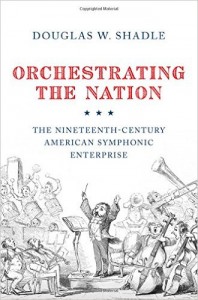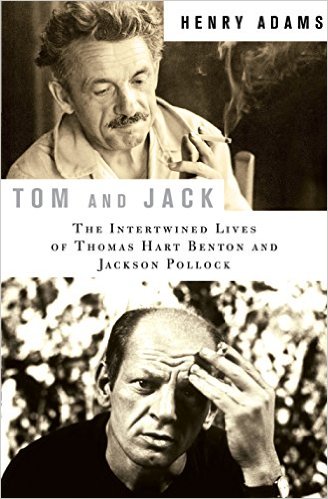 Two books I’ve read recently had a notable impact on me. One was Orchestrating the Nation: The Nineteenth-Century American Symphonic Enterprise (Oxford) by Douglas Shadle, who’s at Vanderbilt. It’s a history of the relationships among 19th-century American composers, critics and conductors, and particularly of the Europhile bias American composers had to face at every step. Music critics were enamored of what came to be called The Beethoven Problem: a composer of symphonies had to both imitate and expand on the Master’s principles. They developed a set of binary goalposts that could be relocated to frustrate any American contender: If your music was too similar to Beethoven’s, it was derivative; if not similar enough, it failed to build on eternal principles. If it followed the Mendelssohn-Schumann line it was timid; if it veered toward Liszt and Wagner, it was damned for being mere program music. If it used American source material, it lacked “symphonic dignity”; if not, it represented inauthentic European wannabe-ism. If audiences loved it though the critics didn’t, then it merely appealed to the superficial; and even if critics liked it and audiences didn’t, then it may be intellectual but will never appeal to the common man. Meanwhile, Europeans as minor as Jan Kalliwoda were enthusiastically welcomed into the repertoire. As Shadle puts it, “critics relegated the music of nineteenth-century American composers to the dustbin of history while applying mutable standards of criticism to each new crop [p. 263]”. And so each new American symphonist – Anthony Philip Heinrich, William Henry Fry, George Frederick Bristow – would create a frisson of public excitement only to be forgotten and dismissed in short order, creating a mistaken impression that no history of American symphonic music existed.
Two books I’ve read recently had a notable impact on me. One was Orchestrating the Nation: The Nineteenth-Century American Symphonic Enterprise (Oxford) by Douglas Shadle, who’s at Vanderbilt. It’s a history of the relationships among 19th-century American composers, critics and conductors, and particularly of the Europhile bias American composers had to face at every step. Music critics were enamored of what came to be called The Beethoven Problem: a composer of symphonies had to both imitate and expand on the Master’s principles. They developed a set of binary goalposts that could be relocated to frustrate any American contender: If your music was too similar to Beethoven’s, it was derivative; if not similar enough, it failed to build on eternal principles. If it followed the Mendelssohn-Schumann line it was timid; if it veered toward Liszt and Wagner, it was damned for being mere program music. If it used American source material, it lacked “symphonic dignity”; if not, it represented inauthentic European wannabe-ism. If audiences loved it though the critics didn’t, then it merely appealed to the superficial; and even if critics liked it and audiences didn’t, then it may be intellectual but will never appeal to the common man. Meanwhile, Europeans as minor as Jan Kalliwoda were enthusiastically welcomed into the repertoire. As Shadle puts it, “critics relegated the music of nineteenth-century American composers to the dustbin of history while applying mutable standards of criticism to each new crop [p. 263]”. And so each new American symphonist – Anthony Philip Heinrich, William Henry Fry, George Frederick Bristow – would create a frisson of public excitement only to be forgotten and dismissed in short order, creating a mistaken impression that no history of American symphonic music existed.
Critics had more power back then than they do now, but Shadle makes clear that star conductors like Theodore Thomas nurtured similar sets of shifting criteria to save themselves the trouble of performing American works. The book’s arch-villain, though, is famous Boston music John Sullivan Dwight. For decades I’ve tried to find something to admire about the guy because of his connection to the Transcendentalists, but he was the worst of the worst of those who thought the Europeans had said it all and so Americans shouldn’t bother trying, and Shadle hangs him with his own hypocritical words again and again. (I’d like to think his type of critic died out with the late Andrew Porter.)
Meanwhile, Shadle also elucidates the aesthetic strategies of the American Romanticists in a way that made me hear them differently. I had always found Fry’s Santa Claus: A Christmas Symphony rather silly, but Shadle discusses it in terms of Italian operatic stereotypes and Fry’s deliberate rebellion against German paradigms, and I now hear it as narrative and somewhat moving. I also developed some admiration, if not affection, for John Knowles Paine’s Second Symphony, as an attempt to master the Liszt/Wagner vocabulary without giving in to programmatic tendencies. The book introduced me to George Templeton Strong’s programmatic Second Symphony Sintram, which is quite impressive and better than the other music I’d heard of his – another work widely lauded and then quickly forgotten. And in the 1880s the next great American composer was supposed to be Brooklynite Ellsworth Phelps (1827-1913), who is almost entirely forgotten today, and the score to his Emancipation Symphony tragically lost. Shadle and I both consider Bristow overdue some major attention, and he includes some excitingly long musical examples from his 1893 Niagara Symphony, about which I’d never been able to find any information.
More than anything else, Orchestrating the Nation illuminates the origins and myriad strategies of the classical music world’s eternal animus against American composers. As I teach every week among student composers who can’t be bothered with Ashley or Nancarrow but sing the praises of Kurtag and Lachenmann, Saariaho and Haas, I feel like little has changed. If it takes a hundred points to achieve parity with Beethoven, you get fifty free points just for being born in Europe. Shadle shows how long that’s been going on.
* * * * * * * * * * * * * * * * * * * * * * * * * * * * *
 The other book is by art scholar Henry Adams, Tom and Jack: The Intertwined Lives of Thomas Hart Benton and Jackson Pollock (Bloomsbury Press). Benton and Pollock have long been two of my favorite painters – my adolescent worship of Pollock has toned down a little over the years, but my fascination with Benton only increases. But the art world, as it turns out, hates Benton for reasons parallel to the condescension of composers toward Sibelius and Rachmaninoff, for his too-late-representational, cheesy-narrative Americana-ness. And so, every account of Pollock’s life soft-pedals his indebtedness to Benton, who was his teacher and lifelong confidant. In the official narrative, Benton was only useful to Pollock as someone to rebel against.
The other book is by art scholar Henry Adams, Tom and Jack: The Intertwined Lives of Thomas Hart Benton and Jackson Pollock (Bloomsbury Press). Benton and Pollock have long been two of my favorite painters – my adolescent worship of Pollock has toned down a little over the years, but my fascination with Benton only increases. But the art world, as it turns out, hates Benton for reasons parallel to the condescension of composers toward Sibelius and Rachmaninoff, for his too-late-representational, cheesy-narrative Americana-ness. And so, every account of Pollock’s life soft-pedals his indebtedness to Benton, who was his teacher and lifelong confidant. In the official narrative, Benton was only useful to Pollock as someone to rebel against.
But Adams – whose ability to elucidate art in words is absolutely thrilling – shows at incontrovertible depth that Pollock used Benton’s methods for energizing a painting throughout his career, and especially at the end; that it was Benton who taught Pollock how to organize a painting, and the difference between Benton’s narrative painting and Pollock’s abstractions does not obscure the means they both used to focus energy within a flat canvas. Adams also takes issue with the whole Clement Greenberg ideology about how what was important about Pollock’s and all the abstractionist painting was the acceptance of flatness, which he finds completely wrong-headed given the evocations of three-dimensional depth in Pollock’s paintings. The book surprised me with how much I could learn about art, even art I was already familiar with, by reading about it. And I loved this musing, at the end, by Benton about what he considered lacking in abstract art:
If you notice: the careers of abstract artists so often end in a kind of bitter emptiness. It’s the emptiness of a person looking into himself all the time. But the objective world is always rich. There is always something around the next bend of the river. [p. 361]
Both books very highly recommended.
